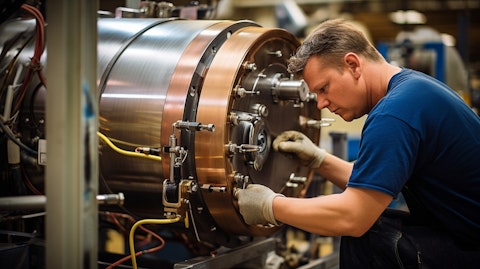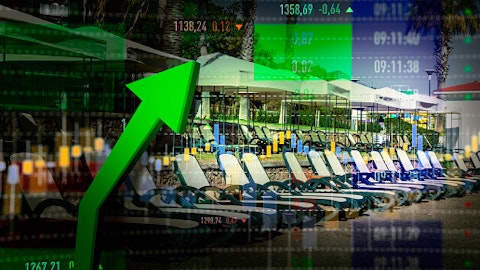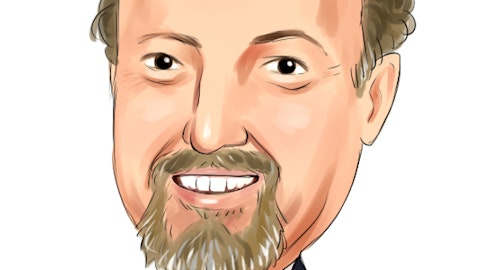A. O. Smith Corporation (NYSE:AOS) Q3 2023 Earnings Call Transcript October 26, 2023
A. O. Smith Corporation beats earnings expectations. Reported EPS is $0.9, expectations were $0.79.
Operator: Welcome to the A. O. Smith’s Third Quarter 2023 Earnings Call. At this time, all participants are in a listen-only mode. [Operator Instructions] Please be advised that today’s conference is being recorded. I would now like to hand the call over to our first speaker for today, Helen Gurholt. Your line is now open.
Helen Gurholt: Good morning, and thank you, everyone, for your patience while we dealt with our technical difficulties. Welcome to our A. O. Smith’s third quarter conference call. I’m Helen Gurholt, Vice President, Investor Relations and Financial Planning & Analysis. Joining me today are Kevin Wheeler, Chairman and Chief Executive Officer; and Chuck Lauber, Chief Financial Officer. In order to provide improved transparency into our operating results of our business, we provided non-GAAP measures. Free cash flow is defined as cash from operations, less capital expenditures. Adjusted earnings, adjusted earnings per share, adjusted segment earnings and adjusted corporate expenses exclude the impact of impairment charges, nonoperating noncash pension income and expenses as well as legal judgment income and terminated acquisition-related expenses.
We also provide total segment earnings. Reconciliations from GAAP measures to non-GAAP measures are provided in the appendix at the end of this presentation and on our website. A friendly reminder that some of our comments and answers during this conference call will be forward-looking statements that are subject to risks that could cause actual results to be materially different. Those risks include matters that we described in this morning’s press release, among others. Also, as a courtesy to those in the question queue, please limit yourself to one question and one follow-up per turn. If you have multiple questions, please rejoin the queue. We will be using slides as we move through today’s call. You can access them on our website at investor.aosmith.com.
I will now turn the call over to Kevin to begin our prepared remarks. Please turn to the next slide.
Kevin Wheeler: Thank you, Helen, and good morning, everyone. I’m on slide 4 and will review a few of our third quarter highlights. I’m very pleased with the execution of our team across all of our businesses to deliver a strong third quarter EPS of $0.90. The performance of our North America segment was particularly strong. We saw resilient demand for our residential water heaters as well as year-over-year improvement in our operating margin. China’s new products drove year-over-year improvement as newly introduced kitchen appliance products were well received by the market. Innovative new products, combined with our strong brand, drove growth despite a continued challenging economic backdrop. India entered the year introducing a number of new products in both the water heating and water treatment categories and has delivered year-to-date sales growth of 17% in local currency.
We also acquired Water Tec, a high-quality Arizona-based water treatment company. This acquisition aligns with our strategic growth aspirations to expand water treatment across the U.S. We welcome Water Tec team to the A. O. Smith family. Please turn to slide 5. North America water heater sales increased 13% in the third quarter as a result of continued strength in residential water heater demand. As you may recall, sales in the third quarter of last year were negatively impacted by channel inventory destocking of residential water heaters, primarily in the wholesale channel. Our North America boiler sales declined 18% in the third quarter against a difficult comp in 2022. In the third quarter last year, we worked down our backlog after making significant production and supply chain improvements.
We believe channel inventories are approaching normal levels. Demand for our commercial high-efficiency condensing boilers, particularly our Hellcat CREST boilers remained steady in the quarter. North America water treatment sales increased 5% in the third quarter of 2023, primarily driven by pricing and e-commerce sales. The quarter also benefited from pricing-related margin improvement. In China, third quarter sales increased 9% local currency compared with the third quarter of 2022, primarily due to our newly introduced dishwasher and steam oven products. The quarter also benefited from higher commercial water treatment sales and positive mix. I’m now on slide 6. We continue to introduce new innovative products in water filtration. I’m pleased to highlight the launch of our new SmartFlow reverse osmosis filtration system under both our A.
O. Smith and Aquasana brands. The product takes up less space and features an easy filter replacement process. Our SmartFlow technology features a multistage filtration process that removes up to 99.9% of 90 contaminants, including PFAS, arsenic, microplastics and lead. It also features our innovative and exclusive side stream reverse osmosis technology, making this one of the most water-efficient systems in the market. This is one example of our commitment to bringing innovative water heating and water treatment — treating products to the global market. On November 6th, at our Investor Day, each of our businesses will highlight new products that are driving results in the marketplace. I’ll now turn the call over to Chuck, who will provide more details on our third quarter performance.
Chuck Lauber: Thank you, Kevin, and good morning, everyone. I’m on slide 7. Third quarter sales in the North America segment were $710 million, a 9% increase over the same period last year. The increase was primarily driven by higher residential water heater volumes that were partially offset by lower boiler volumes. North America segment earnings of $170 million increased 28% compared with the adjusted segment earnings in the third quarter of 2022. Operating margin of 23.9% improved 350 basis points compared to adjusted segment operating margin in the third quarter of last year. The higher segment earnings and operating margin were primarily due to higher residential water heater volumes and lower steel costs, partially offset by lower boiler volumes.

Segment pricing was relatively flat in the quarter compared to last year. Moving on to slide 8. Rest of the World segment sales of $233 million increased 1% year-over-year and 6% on a constant currency basis. Currency translation unfavorably impacted segment sales by approximately $11 million. Sales of newly introduced kitchen appliance products, higher commercial water treatment sales and a positive mix in China drove the sales increase in the quarter. India sales grew 13% in local currency in the third quarter compared to last year. Rest of the World segment earnings of $23 million increased 6% compared to segment earnings in the third quarter of 2022. Segment operating margin was 9.9%, an increase of 40 basis points compared to the same period last year, primarily as a result of higher sales of new products and a positive mix.
Please turn to slide 9. We generated free cash flow of $396 million in the first nine months of 2023, more than 2 times the free cash flow generated in the same period last year. This was largely due to higher earnings and lower working capital cash outlays, primarily related to lower inventory levels and lower 2022 incentive payments paid in 2023. Our cash balance totaled $342 million at the end of September, and our net cash position was $212 million. Our leverage ratio was 6.4%, as measured by total debt to total capital. Our free cash flow and solid balance sheet enable us to focus on capital allocation priorities and return of cash to shareholders. Earlier this month, our Board approved a 7% increase to our quarterly dividend to $0.32 per share.
We repurchased 2.4 million shares of common stock in the first nine months of 2023 for a total of $161 million. We expect to repurchase $300 million of our shares for the full year 2023. Let’s now turn to slide 10. In addition to returning capital to shareholders, we continue to see opportunities for organic growth through innovation and new product development across all of our product lines and geographies. The strength of our balance sheet also allows us to pursue strategic acquisitions along with organic growth. Please turn to slide 11 and our revised 2023 earnings guidance and outlook. We have increased our 2023 outlook with an expected adjusted earnings per share range of $3.70 to $3.80 per share. The midpoint of our adjusted earnings per share range represents an increase of 19% compared with 2022 adjusted EPS.
Our outlook is based on a number of key assumptions, which include a stable supply chain with limited disruption. We have increased our North America full year margin guidance to be approximately 25% based on our full year outlook on volumes and price cost relationship. We forecast that our Q4 material costs will be similar to our Q3 material costs. Our Rest of the World margin guidance of approximately 10% remains unchanged. We expect to generate strong free cash flow of between $575 million and $600 million. For the year, CapEx should be approximately $65 million. Corporate and other expenses are expected to be approximately $60 million. Our effective tax rate is estimated to be approximately 24%. And with the expectation to repurchase approximately $300 million of shares of our stock, the resulting average outstanding diluted shares, is expected to be 151 million at the end of 2023.
I’ll now turn the call back over to Kevin, who will provide more color on our key markets, top line growth outlook and segment expectations for 2023, staying on slide 11. Kevin?
Kevin Wheeler: Thank you, Chuck. We have narrowed our 2023 sales outlook to grow approximately 2% compared to 2022, which was the high end of our previous guidance. Our outlook includes the following assumptions: Residential water heater orders remained strong through October. Therefore, we project 2023 residential water heater industry volumes will increase approximately 4% compared to last year. We continue to monitor proactive replacement and new housing completions, both of which remain favorable. Demand for commercial electric water heaters greater than 55-gallon continue to be robust. Our guidance for commercial water heater industry volumes to increase mid-teens compared to 2022 is unchanged. We maintain our guidance that our sales in China will grow 3% to 5% local currency in 2023.
Our forecast assumes that the Chinese currency will devalue approximately 6% in 2023 compared to 2022. Our boiler business outlook of being down high single digits compared to last year is unchanged. As a reminder, 2022 is a difficult comp. We entered last year with a large backlog, which we worked down and exited the year with a normalized backlog, partially contributing to our boiler business growth of 28% in 2022. Our outlook for North America water treatment sales is to grow approximately 5% to 7% for 2023 also has not changed. We project that our sales in India will grow 15% this year. Please turn to slide 12. Again, we are very pleased with our performance in the first nine months of 2023. In North America, residential commercial water heater demand remained strong through the third quarter.
The year is lining up to have a normalized split of approximately 52% of volume in the first half of the year and 48% in the back half of the year. As we expected, North America operating margin was down sequentially in the quarter, but remained strong relative to historical performance at 23.9%, even as we recognized higher steel costs in the quarter, compared to the first half of the year. In China, the team continues to execute very well across our various product lines through a balanced go-to-market channel strategy. New product introductions, continued growth in commercial water treatment and positive mix led to a 10% operating margin in the quarter. India continues to outperform the industry. We see great potential for our India business as it continues to deliver growth through new product introductions and premium customer service.
Our focus remains on taking care of our customers as we continue to execute our key strategic objectives to advance our position as a global water technology leader. With that, we conclude our prepared remarks, and we are now available for your questions.
Operator: [Operator Instructions] Our first question comes from the line of Michael Halloran of Baird. Your line is now open. We will now move to our next question. Please stand by. Our next question comes from the line of Saree Boroditsky from Jefferies. Your line is now open.
See also 20 Most Valuable Business Lessons to Make You More Successful and 10 Fastest Growing Regions in the World.
Q&A Session
Follow Smith A O Corp (NYSE:AOS)
Follow Smith A O Corp (NYSE:AOS)
Saree Boroditsky: Hi. Good morning. Congrats on the quarter. So just digging a little bit more about North America residential water demand, it obviously came in much stronger than you initially anticipated at the start of the year. What’s been the biggest surprise for you as you went from thinking volumes are going to be down 3% to 5% to now up 4%? And how does that set you up as we look into 2024?
Kevin Wheeler: Well, I’ll tell you — and we’ve been talking about it each quarter, a biggest surprise has been the proactive replacement side of the business. That’s — we thought that would moderate as we came into 2023. And quite frankly, it stayed strong and continues to be strong. And we’re very pleased with our number of completions that’s been positive as well. So you put those two together, a surprise, yes, but along with having that strong convergence in place. I mean, you put the two together, and it’s been a good year for water heater demand, and we see that continuing into the fourth quarter.
Saree Boroditsky: And then maybe just staying on that similar type of question. Obviously, North America margins have been stronger than you expected. It looks like price cost has been better. What was that contribution in the quarter? Is there anything else outside of higher volumes that we should think about with this year’s margin performance? And is it a good starting point as we think about 2024?
Chuck Lauber: Yes. I mean, when you look at our organic growth for the North America segment — this is Chuck, by the way. Good morning. The pricing contributed very little to segment growth. We had a little bit of incremental pricing on the boiler and water treatment side, a slight headwind on the water heating side. But most of the organic growth in North America was contributed to volume.
Saree Boroditsky: Is there any onetime items in this year that we should think about or is this a good starting point for — as we think about 20242?
Chuck Lauber: No, there’s nothing significantly — nothing significant from a onetime item. We are pleased with how the quarter came out from a margin perspective. Margins remain fairly resilient.
Operator: Please stand by for our next question. Our next question comes from the line of Nathan Jones of Stifel. Your line is now open.
Nathan Jones: I just wanted to follow up on the proactive replacement side of the business, and just see if you can give any more color or any thoughts around why that continues to be so strong. I mean, I would have — I know part of that is typically generated when you have sales in existing homes. Obviously, high interest rates discourage the sale of existing homes, but that business has continued to be really strong for you guys. Do you think there’s something that’s structurally changed in that market? Would you still expect it to go back to a more normal mix or a more traditional mix of the business? Just any more commentary you can give us on why you think that business is and continues to be so strong?
Kevin Wheeler: Well, you outlined many of the reasons right now. Certainly, people are staying in homes. There’s higher renovation. People aren’t moving, so they’re taking different actions. There’s some anecdotal here that we just have to be careful with. Really proactive replacement has been trending up since about 2019. And so, we don’t take one year as a trend. But we’re in our fourth year here, and it hasn’t really changed. And there’s some anecdotal evidence here that there’s some generational impact here. And so, where you look at a maybe a baby boomer would wait till it breaks, maybe the younger generation, Gen Zs and millennials indicate that they do a bit more proactive work than their predecessors.



